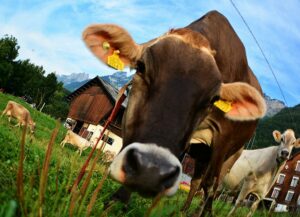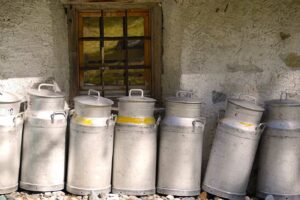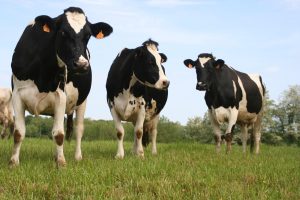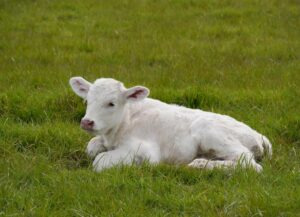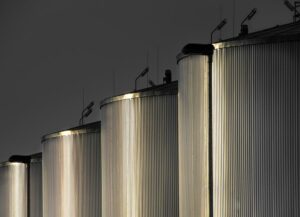Alvaro Garcia
Warm weather in the US varies in length and intensity depending on the state and can lead to heat stress in dairy cows. It has been estimated that dairy production alone accounts for 37.5% (ca. $900 million) of the annual livestock production losses associated with heat stress. These losses are multi-factorial and mostly attributed to milk production, changes in milk composition, less than optimal reproductive performance, and culling rates.
There’s plenty of research on practices to cool-off cows by evaporative heat losses such as shade, fans, sprinklers, and tunnel cooling. Cows cope with excessive environmental heat conditions by several physiologic strategies such as evaporative heat loss (perspiration), increasing respiration rate (panting), reducing heat of fermentation (caloric increment) by cutting-off intake, and feed sorting to choose more easily digestible feed particles. There has been consensus in the past however, that a decrease in intake to reduce the caloric increment is the primary driver leading to decreased milk yield in cows subjected to heat stress.
More recently however, some researchers suggested this mechanism accounts for only 35 to 50% of milk yield losses with likely other physiological factors accounting for the difference. Changes in milk composition have been reported (i.e. decreased milk protein) which seem to be unrelated to feed intake, maybe result of a reduction of protein precursors to the mammary gland, the partitioning of amino acids for other processes, such as gluconeogenesis, and the acute phase protein, and heat shock protein synthesis.
Supplementing diets with rumen-protected amino acids, has reportedly improved milk yield and components concentration. Lactation performance and reduced inflammatory responses were observed with rumen-protected methionine during the transition period in other experiments. A recent study (Pate et al. 2020) evaluated the effects of rumen-protected methionine on lactation performance and physiological responses of multiparous Holstein cows subjected to heat stress. Housing was in a tie-stall barn and diets were formulated based on 180 DIM, 750 kg of BW, 40 kg of milk/d with 3.7% milk fat and 3.2% milk protein, and predicted DMI of 25.5 kg/d.
Cows were randomly assigned to 1 of 2 dietary treatments:
- Total mixed ration with methionine at 1.05 g/kg of dry matter intake
- Total mixed ration without methionine (control)
Within each dietary treatment cows were randomly assigned to 1 of 2 environmental groups (split-plot crossover design): thermoneutral or heat stress.
The study was divided into two periods with 2 phases per period. During phase 1 (9 days), cows were in thermoneutral conditions and fed ad libitum. During phase 2 (also 9 days), group 1 had a heat stress challenge with electric heat blankets (1.87 × 1.59 m; 100% nylon with polyurethane coating, consisting of 12 infrared heating pads generating a temperature of 36°C). After 21-d, the study was repeated (period 2) but now reversing the treatments of period 1, such that dietary treatments (methionine or control) were the same for each cow.
Cows exposed to the heat stress challenge showed the typical physiological changes associated with hyperthermia like those observed in commercial dairies. There was an increase in skin, rectal, and vaginal temperatures, as well as in respiration and heart rates. Rumen-protected methionine did not influence any of these physiological parameters during heat stress. Heat stress however affected the cow behavior in this experiment. There was an increase in standing time and reduced lying time in cows on heat stress conditions. Although this was not the aim of this experiment it can be speculated that cows that spend more time standing could have increased susceptibility to hoof lesions. Cows that were in pair-fed conditions reduced their intake and milk yield when compared to those in the heat stress challenge.
The addition of rumen-protected methionine improved milk composition during heat stress, with higher concentrations of milk fat and protein. Intake, milk yield, and feed efficiency however were not affected by rumen-protected methionine during the heat stress challenge. Other parameters that need evaluation are the effects of feeding methionine during heat stress on blood parameters, immunity, and liver and mammary gland functions. Other aspects for future research are the overall lactation performance and health taking into consideration the duration and severity of the heat stress.
Reference:
Pate, R.T., Luchini, D., Murphy, M.R., Cardoso, F.C. 2020. Effects of rumen-protected methionine on lactation performance and physiological parameters during a heat stress challenge in lactating Holstein cows. Journal of Dairy Science. 103:2800–2813.
© 2020 Dairy Knowledge Center. All Rights Reserved



